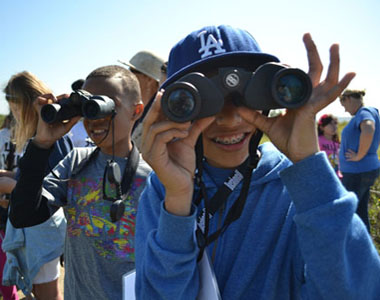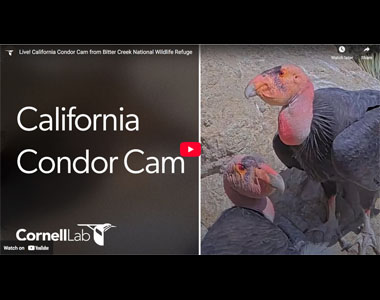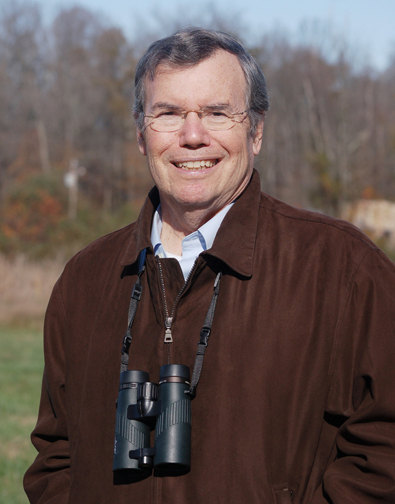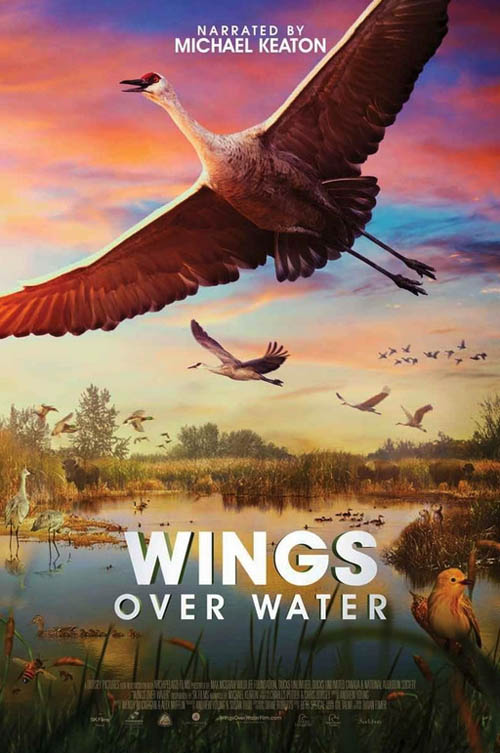| | Birding is booming. Over a third of Americans are watching, filming, following birds from their backyards to the groomed grounds of college campuses. And even more Americans are being introduced to birds and birding on their devices, through dazzling documentaries, artwork and installations, indoors and out.  That’s why our October issue of RCC’s Bird Watch and Wonder begins with Ross Feldner’s compilation of the astounding aspects of today’s birdwatching by the numbers. Then, to underscore that birding is now definitely cool and trending among the young, we take you to the campus birding club at the University of Nevada, Las Vegas (UNLV) where the students have forsaken casinos for Canvasbacks and Cinnamon Teal. And at Cal State Stanislaus, Professor Laurissa Hamilton leads monthly bird walks that include community members and other nearby colleges like Modesto Community College who get the benefit of the university’s resources. That’s why our October issue of RCC’s Bird Watch and Wonder begins with Ross Feldner’s compilation of the astounding aspects of today’s birdwatching by the numbers. Then, to underscore that birding is now definitely cool and trending among the young, we take you to the campus birding club at the University of Nevada, Las Vegas (UNLV) where the students have forsaken casinos for Canvasbacks and Cinnamon Teal. And at Cal State Stanislaus, Professor Laurissa Hamilton leads monthly bird walks that include community members and other nearby colleges like Modesto Community College who get the benefit of the university’s resources. Birding is also good for you, as columnist Rebecca O’Connor reports in “Bird Findings,” and as we learn from an eloquent and beautifully photographed tribute to the glories of migrating Snow Geese by Bryan Pfeiffer in his latest essay in Chasing Nature, “Geese Are Good For You.” Pfeiffer also lets us know that Snow Geese are not simply awe inspiring. They even offer virtues we can learn from them like fidelity and altruism.  Bird behavior can also give us a slightly guilty belly laugh as in our story (and Bird Cam where you can watch) of how an over eager California Condor knocks his mate off their nest atop the rocky cliffs. And, in our “Videos and Films” section, you can join the growing ranks of birdwatchers who are able to follow the amazing migration journeys of three families of birds — Sandhill Cranes, Yellow Warblers and Mallard Ducks—simply by downloading and streaming “Wings Over Water,” a documentary narrated by Michael Keaton. Bird behavior can also give us a slightly guilty belly laugh as in our story (and Bird Cam where you can watch) of how an over eager California Condor knocks his mate off their nest atop the rocky cliffs. And, in our “Videos and Films” section, you can join the growing ranks of birdwatchers who are able to follow the amazing migration journeys of three families of birds — Sandhill Cranes, Yellow Warblers and Mallard Ducks—simply by downloading and streaming “Wings Over Water,” a documentary narrated by Michael Keaton.
Then you can share it — or the entire October issue of RCC’s Bird Watch and Wonder -- with friends, family, neighbors, colleagues. You can help make an even bigger birding boom. Let’s go for half of all Americans who become fascinated with the world of birds. It will be good for their health and happiness – and for the birds. | | | | | |  Bob Musil is the President & CEO of the Rachel Carson Council and author of Rachel Carson and Her Sisters: Extraordinary Women Who Have Shaped America’s Environment (Rutgers, 2016) and Washington in Spring: A Nature Journal for a Changing Capital (Bartleby, 2016). He is also the editor of the forthcoming annotated edition from Rutgers University Press of Rachel Carson’s Under the Sea-Wind with his Introduction, updated marine science, and historic and contemporary illustrations and photographs. Bob Musil is the President & CEO of the Rachel Carson Council and author of Rachel Carson and Her Sisters: Extraordinary Women Who Have Shaped America’s Environment (Rutgers, 2016) and Washington in Spring: A Nature Journal for a Changing Capital (Bartleby, 2016). He is also the editor of the forthcoming annotated edition from Rutgers University Press of Rachel Carson’s Under the Sea-Wind with his Introduction, updated marine science, and historic and contemporary illustrations and photographs. | | | | | | Birding in America Millions of Americans are enjoying the great outdoors by gazing up and observing birds in an era when technology frequently keeps us glued to screens! 96 million Americans participate in birdwatching, according to Birding in the United States: A Demographic and Economic Analysis, an Addendum to the 2022 National Survey of Fishing, Hunting, and Wildlife-Associated Recreation! Thanks to this detailed analysis, we now have a better understanding of the demographics of birdwatchers and the economic impact of their actions. | | | | | | | | Louisiana Wildlife Federation Promotes “Lights Out Louisiana” Initiative to Protect Migrating Birds The Louisiana Wildlife Federation is calling on building owners, businesses and residents to turn off unnecessary lighting from 11 p.m. to 6 a.m. to help an estimated 500 million migratory birds pass through Louisiana safely. LWF member Charles Williams says migratory birds navigate by the light of the moon and stars, but bright lights can lead to fatal collisions. | | | | | | | | Free As a Bird Chill vibes and a focus on observing and preserving nature have students flocking to UNLV's Birding and Conservation Club. For the 20-plus members of UNLV’s Birding and Conservation Club, the popular saying “birds of a feather” is more than an idiom, it’s a way for students, faculty, staff, or even community members to “unplug,” connect with nature, and practice conservation alongside those who share a similar enthusiasm for observing birds. | | | | | | | | Bird Walks Bring Students and Community Together on Campus The first Bird Walk of the 2025-26 school year kicked off on Sept. 25 for the third year in a row. Bird Walks happen once a month on a Thursday, guided by our campus’ own bird experts, going around campus to see different species of birds. Dr. Laurissa Hamilton, host of the Bird Walks and professor in the Biology department, was excited to start another year. She shared that the event is more than simply going out and looking for birds. | | | | | | | | What to Grow in Fall If You Want Migrating Birds to Stop in Your Garden As summer fades away and fall settles in, birds in North America begin preparing for the cold season—and your yard can become a vital fueling station for these feathered visitors. By planting the right flowers, plants and shrubs you can support migrating and overwintering birds while also enjoying a colorful, wildlife-friendly landscape. | | | | | | | | Spending Time With Birds Has Health Benefits In the days that followed the Sept. 11 attacks our soundscape changed. The ever-present thrum of aircraft was silenced, and the shift was eerie and uncomfortable. I had never realized how many airplanes I could hear even when they weren’t visible. They had just always been there and suddenly the world sounded wrong. A few days later the planes returned, and I felt a little less on edge. I think it was this realization that the world could sound off kilter that made me start paying more attention to bird songs and how they affected me. | | | | | | | | Saving Puget Sound’s Puffins: Bringing These Ocean Ambassadors Back From the Brink Hundreds of seabirds clung to Williamson Rocks, a guano-covered cluster of stone and grass rising just above the high tide line in Burrows Bay, near Anacortes, Washington. The spectacle drew a flurry of shutter clicks from photographers on a passing tour boat. The islet brimming with cormorants and gulls was missing at least one photogenic element, though. | | | | | | | | Where Have All the Backyard Birds Gone? Backyards that once erupted with the chatter of sparrows feel quieter. Fields that used to ring with the calls of blackbirds and meadowlarks now sit in an uneasy silence. Even the evening skies, once alive with the swooping swallows chasing a nighttime snack, seem strangely empty. Since 1970, nearly 3 billion birds have vanished from North America’s skies — almost one in every four. And most startling, it isn’t the rare species being lost first; it’s the sparrows, swallows, jays and thrushes that once seemed too abundant to ever fail. | | | | | | | | Rare Bird Sightings Are on the Rise in Texas—But Why? Texas birders have been treated to an unusual streak of sightings this year, including species that rarely, if ever, make an appearance in the state. In September, a double-striped thick-knee was spotted in South Texas—just the second recorded sighting of a Central and South American bird in the state since 1961. More recently, a northern jacana, a tropical shorebird from Mexico and Central America, turned up at a wildlife refuge in the Lower Rio Grande Valley for the first time in nearly a decade. | | | | | | | | Male Condor Knocks Mate Off Cliff During Courtship Display The adult condors on our new California Condor cam broadcasting from Southern California put on a show for us over the weekend! After arriving to the nest area together, they moved out toward the rocky edge, whereupon the male stretched out his wings and began performing a courtship display called the “wing-out” display for the female. He was so enthusiastic that she ran out of room and had to fly off, with him in hot pursuit. | | | | | | | | | | Rare Hybrid Bird Discovered in Texas Backyard Biologists at The University of Texas at Austin have documented an unusual bird that appears to be the offspring of a green jay and a blue jay. They believe this may represent one of the first known cases of a hybrid animal arising in the wild because of recent shifts in climate. Although these two parent species are separated by about 7 million years of evolution, their habitats did not overlap until only a few decades ago. | | | | | | | | Geese are Good for You WHAT’S left to say about geese flying south for winter? Hackneyed as frost on the pumpkin (or pumpkin-spice anything), worn as the falling leaves, what have geese done for us lately? Well, that’s up to us. It turns out that geese, among the most familiar birds on Earth, have a lot to say (er, honk) to us about fidelity, altruism, and awe. If only we’d let them. (I even have a stupid joke for you about geese.) | | | | | | | | The Symbolism of Birds in Stories Birds have long been seen as rich symbols in literature and storytelling, with each species often representing unique qualities or characteristics. The symbolism behind birds in stories can vary based on their behaviors, appearances, and roles in nature, leading to powerful associations with certain human experiences and emotions. Let’s explore what different birds symbolize in creative writing and storytelling. | | | | | | | | 10 Ancient Greek Myths About Birds In ancient Greece birds represented power, freedom and wisdom and show up in numerous Greek myths and legends where they most often appear as messengers of the gods, oracles and even gods themselves. Metamorphosis is a typical theme in Greek mythology where gods, as well as mortals, had the power to transform into different creatures allowing them to trick and manipulate. So it was with birds which were endowed with the same magical power. | | | | | | | | When the Rio Runs Dry Audubon Southwest's efforts to provide refuge for wildlife on the Rio Grande. The Rio Grande in New Mexico has had a rough year. A record-low snowpack this past winter, combined with limited storage capacity due to ongoing upgrades at El Vado Dam, left the river’s water reserves nearly empty. More than 75 miles of the river dried up this summer, including the Albuquerque stretch. | | | | | | | | Birds and Climate Change The most critical threat to birds and our planet at large, Climate Change affects all habitats in different ways. Rising sea levels are particularly ominous for coastal communities of both birds and people, but many non-coastal bird species may also be adversely affected by rising temperatures. According to National Audubon’s climate report, Survival by Degrees: 389 Bird Species on the Brink, two-thirds of North American birds are at increasing risk of extinction from global temperature rise | | | | | | | | A Tiny Seabird Faces Growing Threats in the Forest Nesting often high in the redwoods’ canopy, the marbled murrelet faces new and longstanding risks. Russian fur traders settled at Fort Ross on the rock-studded California coast in 1812, felling a grove of towering redwood trees for lumber to build a fort, homes and a church. More than two centuries later, the fort is a state park, and the redwood grove has regained the shady, canopy feel of old-growth forest, with a fern-bedecked floor and a creek purling beneath. | | | | | | | | So Many Birds Are Migrating That They’re Appearing on Weather Radar Up to half a billion birds are migrating southward each night. Researchers can use weather radars to track them. Hundreds of millions of birds are taking to the skies each night, southward-bound in search of warmer weather — so many that you can spot them on weather radar. It’s data that researchers can use to estimate how many birds are in the skies and where they’re going. | | | | | | | | Why Birds Sang After a Total Solar Eclipse, According to New Research The total solar eclipse in North America on April 8, 2024, temporarily reset the biological clocks of some bird species, according to new research. The eclipse created a dramatic spectacle as the moon moved between Earth and the sun, plunging midday into a few moments of total darkness along a path from Mazatlán, Mexico, to St. Johns in Newfoundland, Canada. | | | | | | | | A Mystical Ornithology “To let that cacophony wash over you, you almost have to divorce your mind from identifying anything. You just let everything that is, be what it is.” This week, we bring you a film that spans the three themes we are exploring in print. It offers a taste of the larger frame that holds together our new issue, and the paradoxical ways we are entwined with the seasons through requiem, invitation, and celebration, each a thread we will unfurl in the coming months. | | | | | | | | Blithewold’s Big Bamboo Birds Meant to Send Message of Conservation It used to be possible to see an eastern bluebird or a sandhill crane around the gardens at Blithewold Manor on an average day, but now there are two gigantic examples of the two species perched on the grounds all the time. The big bamboo birds are a part of an installation of sculptures dotted around the 100-plus-year-old property created by artists Andy Moerlein and Donna Dodson, aka Mr. & Mrs. Myth Maker. The married couple have collaborated for 15 years, creating large-scale outdoor art. | | | | | | | | Classical Music (is) for the Birds Q: What do you call birds who don’t know the song lyrics? A: Hummingbirds. Cheeky blog title aside, there are many examples of classical composers who have been inspired by birds, bird legends, and of course, bird songs. While clucking chickens and elegant swans and others in the avian world aren’t necessarily limited to springtime appearances, I thought it would be fun to put the birds front and center now that it’s the season we start to spend more time outdoors. | | | | | | | | California Condors Hosted by US Fish and Wildlife Service Bitter Creek National Wildlife Refuge, CA This year’s California Condor Cam experience focuses on not only a new nest, but a new wildlife refuge. This year’s nest is in Orchard Draw located on the Bitter Creek National Wildlife Refuge, featuring #328 (male), #216 (female), and #1379 (chick). | | | | | | | | White-breasted Nuthatch Do you have a bird feeder in your backyard? Then it’s likely you’ll see this perky little visitor, a distinctive gray, black and white bird that is common in United States where its nasally call can be heard all year long. Because the White-breasted Nuthatch wedges its excess food into tree bark crevices, it's often spotted in densely wooded areas or open spaces with large trees. While often seen at bird feeders, during the summer the White-breasted Nuthatch feeds on insects like beetles, ants, and caterpillars. | | | | | | | | Momentary Meditations are published every Monday to awaken what Rachel Carson called “the sense of wonder” and what Albert Schweitzer called “a reverence for life.” Looking deeply into our interdependence with all life on earth helps us know what we must do. In our harried world, these meditations are meant to serve as a renewable resource for compassion and love. Hope Lifts - “We grow up, but the world remains a child...” -these words by Rainer Maria Rilke settled into me as I watched this pair of ospreys rebuild a nest created by older birds who once sang and are now still. | | | | | | | |  Wings over Water Wings over Water
Narrated by Michael Keaton
As the glaciers retreated at the end of the last ice age, they left an astounding gift of connected rivers, lakes and wetlands across the heartland of North America. Today, these largely unknown water highways remain an oasis for sustaining wildlife. From the herds of bison that still roam the Great Plains to the vital honeybees that pollinate our crops and especially for the millions of magnificent birds that migrate along these “flyways.”
Wings Over Water tells the story of the epic journeys of three amazing bird families – the Sandhill Crane, the Yellow Warbler and the Mallard Duck – with extraordinary footage of their fascinating behaviors. Audiences will be captivated by the triumphs and challenges of these remarkable creatures that defy all odds and soar across mountains, deserts, cities and forests as they head home to raise their young. Click here to stream on Vimeo | | | | | | Where Have All the Birds Gone?
Nature in Crisis By Rebecca E. Hirsch Birds are disappearing.  Birds are nature’s essential workers, and they are crucial members of ecosystems around the world. Hummingbirds pollinate our flowers; cardinals munch on beetles, grasshoppers, and other pests that damage crops; owls eat rodents that can spread disease; vultures clean up roadkill and other waste. Beyond their practical aspects, birds bring us joy through their songs and beautiful feathers. Birds are nature’s essential workers, and they are crucial members of ecosystems around the world. Hummingbirds pollinate our flowers; cardinals munch on beetles, grasshoppers, and other pests that damage crops; owls eat rodents that can spread disease; vultures clean up roadkill and other waste. Beyond their practical aspects, birds bring us joy through their songs and beautiful feathers.
But since 1970, nearly 30 percent of all birds in the United States and Canada have vanished. Scientists are scrambling to figure out what may be causing such a drastic decline. The answer: humans. City lights and tall glass skyscrapers disorient migrating birds. Domesticated cats prowling outdoors kill billions of birds each year. Pesticides contaminate fish and insects, which are then consumed by birds of prey. And climate change might disrupt and even wipe out feeding grounds for entire species.
Discover the vast impacts birds have on ecosystems, food systems, and human communities, and learn more about what scientists are doing to protect them. “Never have my astonishment, wonder, and admiration been so stirred as when I have witnessed these birds drop from their course like meteors from heaven.” —Simon Pokagon, Potawatomi tribal leader “In pushing other species to extinction, humanity is busy sawing off the limb on which it is perched.” — American biologist Paul R. Ehrlich “There’s something everyone can do in their lives and in their communities to make it a better place for birds and people.” — Gary Langham, chief scientist, National Audubon Society Click here to purchase | | | | | | | | | | The October 2025 issue of Bird Watch and Wonder was produced by Ross Feldner | | | |  The Rachel Carson Council Depends on Tax-deductible Gifts From Concerned Individuals Like You. Please Help If You can. The Rachel Carson Council Depends on Tax-deductible Gifts From Concerned Individuals Like You. Please Help If You can. | | | |  Sign Up Here to Receive the RCC E-News and Other RCC Newsletters, Information and Alerts. Sign Up Here to Receive the RCC E-News and Other RCC Newsletters, Information and Alerts. | | | | | | | | | | | |